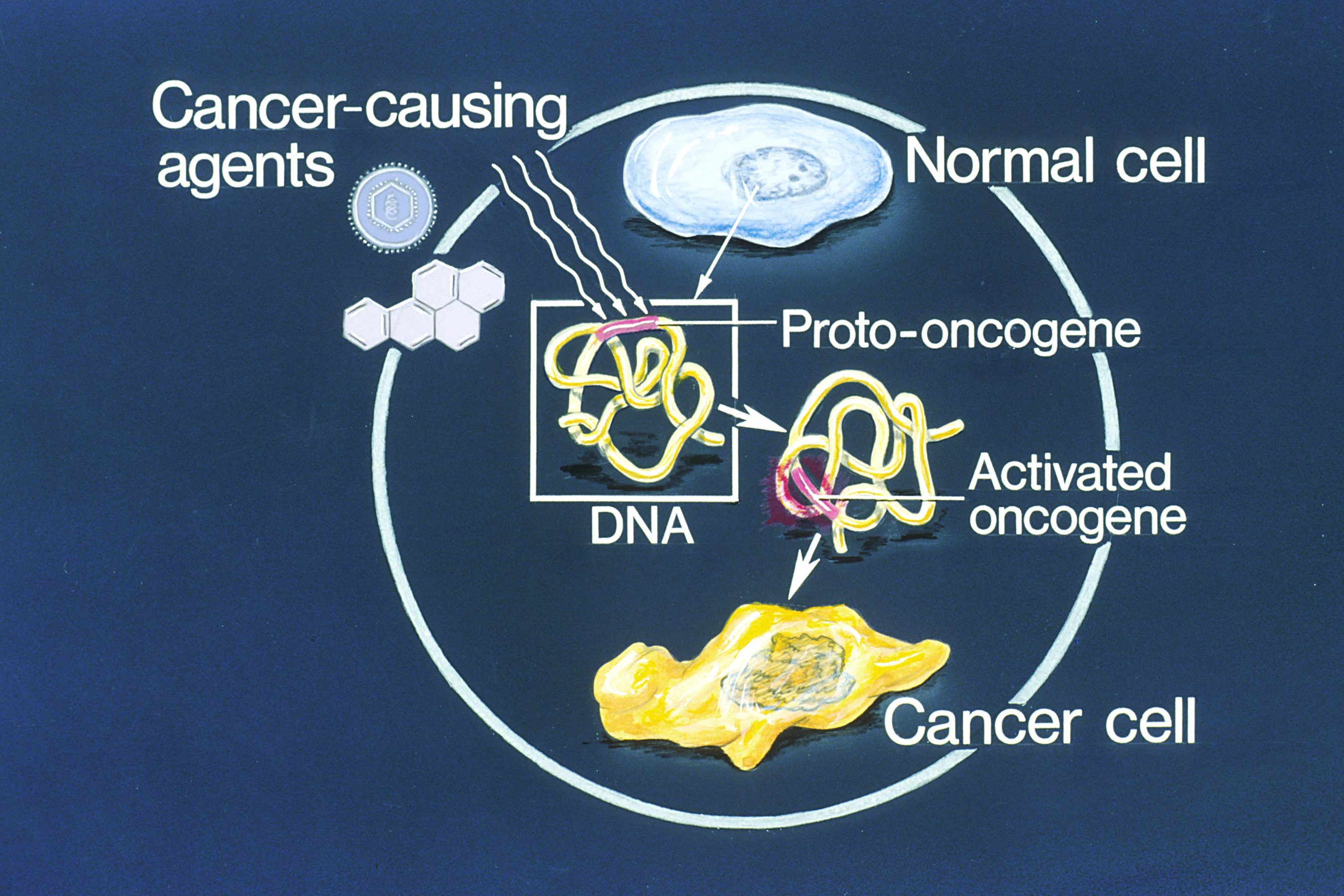|
Competing Endogenous RNA
In molecular biology, competing endogenous RNAs (abbreviated ''ceRNAs'') regulate other RNA transcripts by competing for shared microRNAs (miRNAs). Models for ceRNA regulation describe how changes in the expression of one or multiple miRNA targets alter the number of unbound miRNAs and lead to observable changes in miRNA activity - i.e., the abundance of other miRNA targets. Models of ceRNA regulation differ greatly. Some describe the kinetics of target-miRNA-target interactions, where changes in the expression of one target species sequester one miRNA species and lead to changes in the dysregulation of the other target species. Others attempt to model more realistic cellular scenarios, where multiple RNA targets are affecting multiple miRNAs and where each target pair is co-regulated by multiple miRNA species. Some models focus on mRNA 3' UTRs as targets, and others consider long non-coding RNA targets as well. Hundreds of publications have described the influence of ceRNA regulati ... [...More Info...] [...Related Items...] OR: [Wikipedia] [Google] [Baidu] |
MicroRNA
Micro ribonucleic acid (microRNA, miRNA, μRNA) are small, single-stranded, non-coding RNA molecules containing 21–23 nucleotides. Found in plants, animals, and even some viruses, miRNAs are involved in RNA silencing and post-transcriptional regulation of gene expression. miRNAs base-pair to complementary sequences in messenger RNA (mRNA) molecules, then silence said mRNA molecules by one or more of the following processes: * Cleaving the mRNA strand into two pieces. * Destabilizing the mRNA by shortening its poly(A) tail. * Reducing translation of the mRNA into proteins. In cells of humans and other animals, miRNAs primarily act by destabilizing the mRNA. miRNAs resemble the small interfering RNAs (siRNAs) of the RNA interference (RNAi) pathway, except miRNAs derive from regions of RNA transcripts that fold back on themselves to form short stem-loops (hairpins), whereas siRNAs derive from longer regions of double-stranded RNA. The human genome may encode ov ... [...More Info...] [...Related Items...] OR: [Wikipedia] [Google] [Baidu] |
Phosphoinositide 3-kinase
Phosphoinositide 3-kinases (PI3Ks), also called phosphatidylinositol 3-kinases, are a family of enzymes involved in cellular functions such as cell growth, proliferation, differentiation, motility, survival and intracellular trafficking, which in turn are involved in cancer. PI3Ks are a family of related intracellular signal transducer enzymes capable of phosphorylating the 3 position hydroxyl group of the inositol ring of phosphatidylinositol (PtdIns). The pathway, with oncogene PIK3CA and tumor suppressor gene PTEN, is implicated in the sensitivity of cancer tumors to insulin and IGF1, and in calorie restriction. Discovery The discovery of PI3Ks by Lewis Cantley and colleagues began with their identification of a previously unknown phosphoinositide kinase associated with the polyoma middle T protein. They observed unique substrate specificity and chromatographic properties of the products of the lipid kinase, leading to the discovery that this phosphoinositide kinas ... [...More Info...] [...Related Items...] OR: [Wikipedia] [Google] [Baidu] |
Versican
Versican is a large extracellular matrix proteoglycan that is present in a variety of human tissues. It is encoded by the ''VCAN'' gene. Versican is a large chondroitin sulfate proteoglycan with an apparent molecular mass of more than 1000kDa. In 1989, Zimmermann and Ruoslahti cloned and sequenced the core protein of fibroblast chondroitin sulfate proteoglycan. They designated it versican in recognition of its versatile modular structure. Versican belongs to the lectican protein family, with aggrecan (abundant in cartilage), brevican and neurocan (nervous system proteoglycans) as other members. Versican is also known as chondroitin sulfate proteoglycan core protein 2 or chondroitin sulfate proteoglycan 2 (CSPG2), and PG-M. Structure These proteoglycans share a homology (biology), homologous globular N-terminal, C-terminal, and glycosaminoglycan (GAG) binding regions. The N-terminal (G1) globular domain consists of Antibody, Ig-like loop and two link modules, and has Hyalur ... [...More Info...] [...Related Items...] OR: [Wikipedia] [Google] [Baidu] |
CDC42
Cell division control protein 42 homolog (Cdc42 or CDC42) is a protein that in humans is encoded by the ''CDC42'' gene. Cdc42 is involved in regulation of the cell cycle. It was originally identified in ''S. cerevisiae'' (yeast) as a mediator of cell division, and is now known to influence a variety of signaling events and cellular processes in a variety of organisms from yeast to mammals. Function Human Cdc42 is a small GTPase of the Rho family, which regulates signaling pathways that control diverse cellular functions including cell morphology, cell migration, endocytosis, cell polarity and cell cycle progression. Rho GTPases are central to dynamic actin cytoskeletal assembly and rearrangement that are the basis of cell-cell adhesion and migration. Activated Cdc42 activates by causing conformational changes in p21-activated kinases PAK1 and PAK2, which in turn initiate actin reorganization and regulate cell adhesion, migration, and invasion. Structure Cdc42 is a homodim ... [...More Info...] [...Related Items...] OR: [Wikipedia] [Google] [Baidu] |
CD44
The CD44 antigen is a cell-surface glycoprotein involved in cell–cell interactions, cell adhesion and migration. In humans, the CD44 antigen is encoded by the ''CD44'' gene on chromosome 11. CD44 has been referred to as HCAM (homing cell adhesion molecule), Pgp-1 (phagocytic glycoprotein-1), Hermes antigen, lymphocyte homing receptor, ECM-III, and HUTCH-1. Tissue distribution and isoforms CD44 is expressed in a large number of mammalian cell types. The standard isoform, designated CD44s, comprising exons 1–5 and 16–20 is expressed in most cell types. CD44 splice variants containing variable exons are designated CD44v. Some epithelial cells also express a larger isoform (CD44E), which includes exons v8–10. Function CD44 participates in a wide variety of cellular functions including lymphocyte activation, recirculation and homing, hematopoiesis, and tumor metastasis. CD44 is a receptor for hyaluronic acid and internalizes metals bound to hyaluronic acid and can a ... [...More Info...] [...Related Items...] OR: [Wikipedia] [Google] [Baidu] |
KRAS
''KRAS'' ( Kirsten rat sarcoma virus) is a gene that provides instructions for making a protein called K-Ras, a part of the RAS/MAPK pathway. The protein relays signals from outside the cell to the cell's nucleus. These signals instruct the cell to grow and divide ( proliferate) or to mature and take on specialized functions ( differentiate). It is called ''KRAS'' because it was first identified as a viral oncogene in the Kirsten RAt Sarcoma virus. The oncogene identified was derived from a cellular genome, so , when found in a cellular genome, is called a proto-oncogene. The K-Ras protein is a GTPase, a class of enzymes which convert the nucleotide guanosine triphosphate (GTP) into guanosine diphosphate (GDP). In this way the K-Ras protein acts like a switch that is turned on and off by the GTP and GDP molecules. To transmit signals, it must be turned on by attaching (binding) to a molecule of GTP. The K-Ras protein is turned off (inactivated) when it converts the GTP to ... [...More Info...] [...Related Items...] OR: [Wikipedia] [Google] [Baidu] |
MiR-122
miR-122 is a miRNA that is conserved among vertebrate species. miR-122 is not present in invertebrates, and no close paralogs of miR-122 have been detected. miR-122 is highly expressed in the liver, where it has been implicated as a regulator of fatty-acid metabolism in mouse studies. Reduced miR-122 levels are associated with hepatocellular carcinoma. miR-122 also plays an important positive role in the regulation of hepatitis C virus replication. Expression and regulation miR-122 was originally identified by cloning of tissue-specific microRNAs in mouse. The liver-specific expression of miR-122 is conserved in zebrafish. miR-122 expression increases during embryogenesis until it constitutes 72% of total miRNA in adult human liver, making it one of the most highly expressed miRNAs in any tissue. In humans, miR-122 is encoded at a single genomic locus in chromosome 18. The primary miR-122 transcript (pri-miR-122) is a long non-coding RNA. Transcription is regulated by HNF4α ... [...More Info...] [...Related Items...] OR: [Wikipedia] [Google] [Baidu] |
Hepatitis C
Hepatitis C is an infectious disease caused by the hepatitis C virus (HCV) that primarily affects the liver; it is a type of viral hepatitis. During the initial infection period, people often have mild or no symptoms. Early symptoms can include fever, dark urine, abdominal pain, and jaundice, yellow tinged skin. The virus persists in the liver, becoming Chronic condition, chronic, in about 70% of those initially infected. Early on, chronic infection typically has no symptoms. Over many years however, it often leads to liver disease and occasionally cirrhosis. In some cases, those with cirrhosis will develop serious complications such as liver failure, hepatocellular carcinoma, liver cancer, or esophageal varices, dilated blood vessels in the esophagus and gastric varices, stomach. HCV is spread primarily by blood-to-blood contact associated with injection drug use, poorly sterilized medical equipment, needlestick injuries in healthcare, and blood transfusions, transfusions. In r ... [...More Info...] [...Related Items...] OR: [Wikipedia] [Google] [Baidu] |
Oncogene
An oncogene is a gene that has the potential to cause cancer. In tumor cells, these genes are often mutated, or expressed at high levels.Kimball's Biology Pages. "Oncogenes" Free full text Most normal cells undergo a preprogrammed rapid cell death () if critical functions are altered and then malfunction. Activated oncogenes can cause those cells designated for apoptosis to survive and proliferate instead. Most oncogenes began as proto-oncogenes: normal genes involved in cell growth and proliferation or inhibition of apoptosis. If, through mutation, normal genes promoting cellular growth are up-regulated (gain-of-function mutation), they predispose the cel ... [...More Info...] [...Related Items...] OR: [Wikipedia] [Google] [Baidu] |
B-cell Lymphoma
The B-cell lymphomas are types of lymphoma affecting B cells. Lymphomas are Tumors of the hematopoietic and lymphoid tissues, "blood cancers" in the lymph nodes. They develop more frequently in older adults and in immunocompromised individuals. B-cell lymphomas include both Hodgkin lymphoma, Hodgkin's lymphomas and most non-Hodgkin lymphomas. They are typically divided into low and high grade, typically corresponding to indolent (slow-growing) lymphomas and aggressive lymphomas, respectively. As a generalisation, indolent lymphomas respond to treatment and are kept under control (in remission) with long-term survival of many years, but are not cured. Aggressive lymphomas usually require intensive treatments, with some having a good prospect for a permanent Cure#Remission, cure.Merck Manual home edition Non-Hodgkin Lymphomas [...More Info...] [...Related Items...] OR: [Wikipedia] [Google] [Baidu] |
BRAF (gene)
''BRAF'' is a human gene that encodes a protein called B-Raf. The gene is also referred to as proto-oncogene B-Raf and v-Raf murine sarcoma viral oncogene homolog B, while the protein is more formally known as serine/threonine-protein kinase B-Raf. The B-Raf protein is involved in sending signal transduction, signals inside cells which are involved in directing cell growth. In 2002, it was shown to be Mutation, mutated in some human cancers. Certain other inherited ''BRAF'' mutations cause birth defects. Drugs that treat cancers driven by ''BRAF'' mutations have been developed. Two of these drugs, vemurafenib and dabrafenib, are approved by FDA for treatment of late-stage melanoma. Vemurafenib was the first approved drug to come out of fragment-based drug discovery. Function B-Raf is a member of the Raf kinase family of growth signal transduction protein kinases. This protein plays a role in regulating the Mitogen-activated protein kinase, MAP kinase/extracellular signal-reg ... [...More Info...] [...Related Items...] OR: [Wikipedia] [Google] [Baidu] |
PTENP1
Phosphatase and tensin homolog (mutated in multiple advanced cancers 1), pseudogene 1, also known as PTENP1, is a human pseudogene. which has a partial reactivated function as a competing endogenous RNA In molecular biology, competing endogenous RNAs (abbreviated ''ceRNAs'') regulate other RNA transcripts by competing for shared microRNAs (miRNAs). Models for ceRNA regulation describe how changes in the expression of one or multiple miRNA targets ... regulating the tumor suppressor gene PTEN.* References Further reading * * * * * * * * {{protein-stub Pseudogenes ... [...More Info...] [...Related Items...] OR: [Wikipedia] [Google] [Baidu] |




